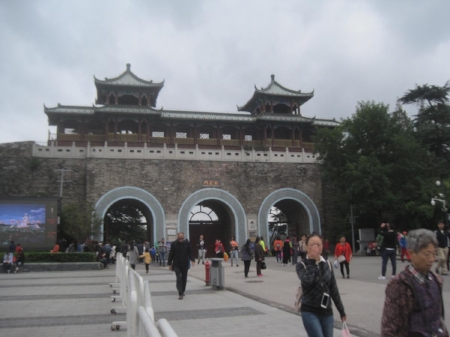2nd Global Soil Biodiversity
By Elizabeth Bach, Executive Director, Global Soil Biodiversity Initiative, Colorado State University
The 2nd Global Soil Biodiversity Conference (GSBC2) was held 15-18 October, 2017 in Nanjing, China. More than 1000 scientists from 47 countries gathered at the Nanjing International Youth Culture Centre to hear about the latest soil biodiversity science, network with colleagues new and old, and share new ideas.
Applying soil biodiversity science to global policy, Dr. Ronald Vargas, the Soils and Land Management Officer at the UN Food and Agricultural Organization and Secretary of the Global Soil Partnership, and Dr. Luca Montanarella, European Commission Joint Research Centre and chair of the Intergovernmental Technical Panel on Soils, called for a formal international assessment on soil biodiversity. There was much excitement around this call and it will be exciting to see it develop.
Conference co-chairs Prof. Ren-fang Shen (Institute of Soil Science, Chinese Academy of Science) and Prof. Yong-guan Zhu (Institute of Urban Environment, Chinese Academy of Science) shared recent developments in soil biodiversity research in China. Soil biology research has accelerated tremendously in the past 5 years in China and support for future work is strong. The China Soil Microbiome Initiative is a more than USD$35 Million project to systematically survey and sequence soil microbial diversity across China and link this biodiversity with key ecosystem services including nutrient cycling, crop production, and carbon storage. Leaders in the Soil Science Institute of the Chinese Academy of Science are seeking additional funding to extend support to include soil animals as well. In addition, the hundreds of Chinses graduate students, postdocs, lectures, and professors in attendance demonstrated deep knowledge, enthusiasm, and curiosity driving soil biodiversity research in China on topics ranging from agricultural production, ecosystem functioning, and restoration. In addition, the 19th National Congress of the Communist Party of China happened in Beijing the same week as GSBC2, and President Xi Jinping specifically included soil and ecological concerns as priorities for the Chinese agenda.
Zhongshan Mountain (Purple Mountain) is east of Nanjing, China.
Photo credit E.Bach
Nanjing International Youth Culture Centre
hosted GSBC2.
Photo credit E.Bach
Dr. Diana Wall, Scientific Chair for the Global Soil Biodiversity Initiative (Colorado State University), highlighted key Global Soil Biodiversity Initiative (GSBI) accomplishments since the 1st GSBC including publication of the Global Soil Biodiversity Atlas (including a new website), publication of many prominent papers, establishment and funding of working groups like sWORM, and incorporation of soil biodiversity into international policy documents including the Global Land Outlook (UNCCD), Global Assessment on Land Degradation and Restoration (Intergovernental Platform on Biodiversity & Ecosystem Services, IPBES, expected spring 2018), and Global Assessment on Soil Biodiversity (IPBES, expected spring 2018).
The GSBC2 featured research from around the world, including Europe, North America, South America (Brazil), Australia, and Africa. The European Joint Research Centre is gearing up for the 2018 Land Use/Land Cover Frame Survey (LUCAS) which will include DNA sequencing analysis for the first time. Dr. Brajesh Singh shared the first published results from the Biomes of Australian Soil Environments survey, showing distribution of bacteria and fungi across the nation. Brazilian scientists shared emerging work focused on soil microbes and fauna in the Amazonia region, investigating impacts of deforestation, agricultural management, and ecological restoration. Several Canadian and American scientists highlighted how soil biodiversity interfaces with global challenges including climate change, providing ecosystem services, ecological restoration success, and plant evolution.
Xuanwu gate to the old Nanjing City Wall
Photo credit E.Bach
Participants enjoy a poster session at GSBC2.
Photo credit E.Bach
In addition to talks and posters, the conference featured several workshops and roundtables to share knowledge between established and early career scientists. Writing workshops were led by Dr. Wim van der Putten (Netherlands Institute for Ecology, NIOO-KNAW), Dr. Karl Ritz (University of Nottingham), and Dr. Josh Schimel (University of California Santa Barbara). In addition, there was an open evening social with the editors of Soil Biology & Biochemistry. Dr. Stefan Geisen (NIOO-KNAW) organized a roundtable featuring experts sharing best practices and emerging methods for studying soil organisms including bacteria, viruses, protists, nematodes, mites, molecular approaches for mesofauna, and working across disciplines and beyond the scientific world. Ting-wen Chen (University of Göttingen, Germany), Dr. Meixiang Gao (Harbin Normal University, China), Dr. Stefan Scheu (University of Göttingen, Germany), and Dr. Tancredi Caruso (Queen’s University of Belfast, Northern Ireland, UK) organized a roundtable focused on ecological theory and soil biota, which spurred exciting discussion late into the evening. Dr. Nadia Soudzilovskaia (Leiden University, Netherlands) and Dr. Gerlinde de Deyn (Wageningen University, Netherlands) organized a roundtable linking soil biodiversity to ecosystem functioning and provisioning of ecosystem services. These provided important opportunities for attendees to interact in focused small-groups and develop important career skills.





